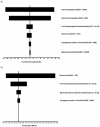Potential cost-effectiveness of universal access to modern contraceptives in Uganda
- PMID: 22363480
- PMCID: PMC3281877
- DOI: 10.1371/journal.pone.0030735
Potential cost-effectiveness of universal access to modern contraceptives in Uganda
Abstract
Background: Over two thirds of women who need contraception in Uganda lack access to modern effective methods. This study was conducted to estimate the potential cost-effectiveness of achieving universal access to modern contraceptives in Uganda by implementing a hypothetical new contraceptive program (NCP) from both societal and governmental (Ministry of Health (MoH)) perspectives.
Methodology/principal findings: A Markov model was developed to compare the NCP to the status quo or current contraceptive program (CCP). The model followed a hypothetical cohort of 15-year old girls over a lifetime horizon. Data were obtained from the Uganda National Demographic and Health Survey and from published and unpublished sources. Costs, life expectancy, disability-adjusted life expectancy, pregnancies, fertility and incremental cost-effectiveness measured as cost per life-year (LY) gained, cost per disability-adjusted life-year (DALY) averted, cost per pregnancy averted and cost per unit of fertility reduction were calculated. Univariate and probabilistic sensitivity analyses were performed to examine the robustness of results. Mean discounted life expectancy and disability-adjusted life expectancy (DALE) were higher under the NCP vs. CCP (28.74 vs. 28.65 years and 27.38 vs. 27.01 respectively). Mean pregnancies and live births per woman were lower under the NCP (9.51 vs. 7.90 and 6.92 vs. 5.79 respectively). Mean lifetime societal costs per woman were lower for the NCP from the societal perspective ($1,949 vs. $1,987) and the MoH perspective ($636 vs. $685). In the incremental analysis, the NCP dominated the CCP, i.e. it was both less costly and more effective. The results were robust to univariate and probabilistic sensitivity analysis.
Conclusion/significance: Universal access to modern contraceptives in Uganda appears to be highly cost-effective. Increasing contraceptive coverage should be considered among Uganda's public health priorities.
Conflict of interest statement
Figures




References
-
- Uganda Bureau of Statistics (UBOS) and Macro International Inc. Uganda Demographic and Health Survey 2006. Calverton, , Maryland,, USA: UBOS and Macro International Inc; 2007.
-
- Vlassoff M, Sundaram A, Bankole A, Remez L, Mugisha F. Benefits of meeting the contraceptive needs of Ugandan women. In Brief, New York: Guttmacher Institute, No. 4; 2009. - PubMed
-
- Sundaram A, Vlassoff M, Bankole A, Remez L, Gebrehiwot Y. Benefits of meeting the contraceptive needs of Ethiopian women. In Brief, New York: Guttmacher Institute, No. 1; 2010. - PubMed
-
- Westoff CF, Bankole A. Reproductive preferences in developing countries at the turn of the century. DHS Comparative Reports No. 2. Calverton, , Maryland,, USA: ORC Macro; 2002.
-
- Sedgh G, Hussain R, Bankole A, Singh S. Women with an unmet need for contraception in developing countries and their reasons for not using a method. Occasional report No. 37. New York: Guttmacher Institute; 2007.
Publication types
MeSH terms
Substances
LinkOut - more resources
Full Text Sources

